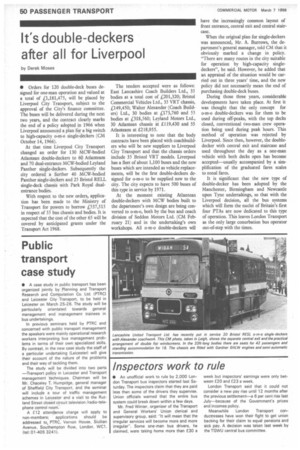It's double-deckers after all for Liverpool
Page 52

If you've noticed an error in this article please click here to report it so we can fix it.
by Derek Moses • Orders for 120 double-deck buses designed for one-man operation and valued at a total of £1,181,475, will be placed by Liverpool City Transport, subject to the approval of the City's finance committee. The buses will be delivered during the next two years, and the contract clearly marks the end of a policy adopted in 1966 when Liverpool announced a plan for a big switch to high-capacity o-m-o single-deckers (CM October 14, 1966).
At that time Liverpool City Transport changed an order for 130 MCW-bodied Atlantean double-deckers to 60 Atlanteans and 70 dual-entrance MCW-bodied Leyland Panther single-deckers. Subsequently the city ordered a further 40 MCW-bodied Panther single-deckers and 25 Bristol RELL single-deck chassis with Park Royal dualentrance bodies.
With respect to the new orders, application has been made to the Ministry of Transport for powers to borrow £537,515 in respect of 55 bus chassis and bodies. It is expected that the cost of the other 65 will be covered by anticipated grants under the Transport Act 1968. The tenders accepted were as follows: East Lancashire Coach Builders Ltd., 35 bodies at a total cost of £201,320; Bristol Commercial Vehicles Ltd., 35 VRT chassis, £149,450; Walter Alexander (Coach Builders) Ltd., 30 bodies at £173,760 and 55 bodies at £318,560; Leyland Motors Ltd., 30 Atlantean chassis at £119,430 and 55 Atlanteans at £218,955.
It is interesting to note that the body contracts have been placed with coachbuilders who will be new suppliers to Liverpool City Transport and that the chassis orders include 35 Bristol VRT models. Liverpool has a fleet of about 1,100 buses and the new buses which are intended as vehicle replacements, will be the first double-deckers designed for o-m-o to be supplied new to the city. The city expects to have 500 buses of this type in service by 1971.
At the moment existing Atlantean double-deckers with MCW bodies built to the department's own design are being converted to o-m-o, both by the bus and coach division of Seddon Motors Ltd. (CM February 21) and in the undertaking's own workshops. All o-m-o double-deckers will have the increasingly common layout of front entrance, central exit and central staircase.
When the original plan for single-deckers was announced, Mr. A. Burrows, the department's general manager, told CM that it obviously marked a change in policy. "There are many routes in the city suitable for operation by high-capacity singledeckers", he said. However, he added that an appraisal of the situation would be carried out in three years' time, and the new policy did not necessarily mean the end of purchasing double-deck buses.
During those three years, considerable developments have taken place. At first it was thought that the only concept for o-m-o double-deckers was for them to be used during off-peaks, with the top decks closed, conventional two-man crew operation being used during peak hours. This method of operation was rejected by Liverpool. Since then, however, the doubledecker with central exit and staircase and used throughout the day as a one-man vehicle with both decks open has become accepted—usually accompanied by a simplification of the graduated fares scales to zonal fares.
It is significant that the new type of double-decker has been adopted by the Manchester, Birmingham and Newcastle upon Tyne undertakings, so that with the Liverpool decision, all the bus systems which will form the nuclei of Britain's first four PTAs are now dedicated to this type of operation. This leaves London Transport as the only large conurbation bus operator out-of-step with the times.












































































































































































